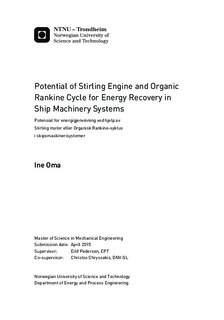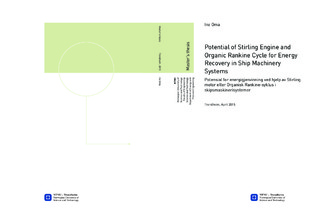| dc.description.abstract | Increasing fuel prices and stricter environmental regulations on emissions are motivating the maritime industry to be innovative on how to save fuel and reduce emissions. New technologies and more efficient use of existing systems can help solving these problems. In this report, a comparative study of the potential for recovering waste heat from a marine dual fuel engine by using Stirling engine or Organic Rankine cycles has been performed. The case vessel was the liquefied gas carrier BW GDF Suez Paris, with four Main Generator Engines, two rated at 11.4 MW, and two at 5.7 MW. The exergy and thermodynamic analyses in this study were based on measurement data from one of the 11.4 MW engines. All calculations and simulations were conducted using the commercial F-Chart Software Engineering Equation Solver.
An exergy analysis was performed on the two main waste heat sources of the case vessel's engine; the exhaust stream and the high temperature jacket cooling water. The exergy in the exhaust stream was 1300 kW at 40% load and increased to 2000 kW for 100% load, which corresponds to 28.5% and 17.6% of the engine's power output respectively. For the cooling water, the exergy was approximately 700-850 kW, or about 6-7.5% of the engine's power output at 100% load.
Three different Organic Rankine cycles were studied; a conventional subcritical cycle, a subcritical cycle with regeneration and superheat and a trans-critical cycle.
A pre-screening of 50 different working fluids was done based on desirable thermophysical, environmental, safety and operational characteristics. A selection of 12 fluids were chosen to be implemented in the thermodynamic analyses. The best thermodynamic performance was found through simulations to be a subcritical cycle with regeneration and benzene as the working fluid, resulting in an efficiency of approximately 21%. Considering hydrocarbons' carcinogenic characteristics and flammability, the safest alternative was shown to be a subcritical Organic Rankine cycle with regeneration and R-245fa as the working fluid. This gave an efficiency of 14.5%, corresponding to 2.5% of the Main Generator Engine's power output at 100% load and 4.1% at 40% load.
A Schmidt cycle analysis of an alpha Stirling engine was performed. The efficiency was calculated to be 22-35%. This is equivalent to 3.9% and 6.1% of the case vessel's main generator engine power output at 100% load. The efficiencies calculated for the Stirling engine were significantly higher than all the Organic Rankine cycle solutions. The best working fluid for Stirling engines seemed to be nitrogen due to its high availability, low cost and limited leakage and diffusion rate out of the engine.
In the feasibility discussion, it was shown that the size of the Stirling engine might not be such a high concern as is typically stated in available research reports. The total volume of the Stirling engine was calculated to be smaller than the total volume of the Organic Rankine system. For the cost analysis, the shortest time until return on investment was calculated for the Organic Rankine cycle technology. Based on European prices for Liquefied Natural Gas, the Organic Rankine system had 3.9 years until Return on Investment, and the Stirling Engine had 6.6 years.
Based on the literature survey, the thermodynamic analyses and the feasibility discussion, the Organic Rankine system showed to be the best solution for waste heat recovery systems in the near future for ships operating on global shipping routes. However, with sufficient investment in research and development of Stirling engines utilizing working fluids possessing good availability and safety, the Stirling engine might be a better solution considering its superior thermodynamic performance compared to Organic Rankine systems. | |

